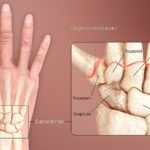Introduction
Rotator cuff injuries are a common cause of shoulder pain and disability, particularly in older adults and those engaged in repetitive overhead activities. The rotator cuff is a group of four muscles and tendons that stabilize the shoulder joint and enable a wide range of shoulder movements. Understanding the symptoms, causes, diagnosis, and treatment options for rotator cuff injuries is crucial for effective management and recovery.
Symptoms of Rotator Cuff Injuries
Rotator cuff injuries can manifest through various symptoms, including:
- Pain: A dull ache deep in the shoulder, often worsening at night.
- Weakness: Difficulty lifting the arm or performing overhead activities.
- Limited Range of Motion: Stiffness and reduced ability to move the shoulder.
- Crackling Sensation: A popping or crackling sound when moving the shoulder.
- Arm Weakness: Difficulty lifting or rotating the arm, especially during activities like combing hair or reaching behind the back.
Causes and Risk Factors
Rotator cuff injuries can be caused by acute trauma or degenerative changes over time. Common causes and risk factors include:
- Acute Injuries: Falls, heavy lifting, or sudden jerking motions can lead to tears.
- Degenerative Wear: Age-related degeneration due to decreased blood supply, repetitive stress, and bone spurs.
- Repetitive Overhead Activities: Sports like baseball, tennis, and occupations involving repetitive arm movements increase risk.
- Family History: Genetic predisposition to shoulder problems.
- Poor Posture: Can contribute to shoulder impingement and rotator cuff injuries.
- Smoking and Obesity: These factors can impair healing and increase the risk of injury.
Diagnosis
Diagnosing a rotator cuff injury typically involves a combination of medical history, physical examination, and imaging tests. Diagnostic steps include:
- Physical Examination: Assessing shoulder tenderness, range of motion, and arm strength.
- Imaging Tests: X-rays to detect bone spurs or arthritis, MRI, or ultrasound to visualize soft tissues and confirm the extent of the injury.
Treatment Options
Treatment for rotator cuff injuries varies based on the severity of the tear and the patient’s activity level. Options include:
Nonsurgical Treatments
- Rest and Activity Modification: Avoiding activities that exacerbate symptoms.
- Physical Therapy: Exercises to improve flexibility, strength, and range of motion.
- Medications: NSAIDs to reduce pain and inflammation.
- Corticosteroid Injections: To provide temporary relief from severe pain and inflammation.
Surgical Treatments
Surgery may be recommended for severe tears or when nonsurgical treatments fail. Surgical options include:
- Arthroscopic Surgery: Minimally invasive procedure using small incisions and a camera to repair the tear.
- Open Surgery: In cases where a larger incision is necessary to repair extensive damage.
- Reverse Shoulder Replacement: For severe rotator cuff damage, where the anatomy of the shoulder joint is altered to improve function and reduce pain.
Rehabilitation
Rehabilitation is a critical component of recovery from a rotator cuff injury, involving:
- Initial Immobilization: Wearing a sling to immobilize the shoulder post-surgery.
- Physical Therapy: Gradual exercises to restore range of motion and strength, starting with passive movements and progressing to active and strengthening exercises.
- Home Exercises: Consistent exercise routine to maintain progress and prevent re-injury.
FAQs
What are the first signs of a rotator cuff injury?
The first signs often include a dull ache in the shoulder, difficulty lifting the arm, and pain that worsens at night or with certain movements.
Can a rotator cuff tear heal on its own?
Partial tears can sometimes improve with rest, physical therapy, and other nonsurgical treatments. However, complete tears usually require surgical intervention.
How long does it take to recover from rotator cuff surgery?
Recovery can take several months to over a year, depending on the severity of the tear and the patient’s adherence to rehabilitation protocols.
Is physical therapy necessary after rotator cuff surgery?
Yes, physical therapy is essential for restoring shoulder function and strength and for ensuring a successful recovery.
What exercises help strengthen the rotator cuff?
Exercises such as shoulder stretches, strengthening with resistance bands, and specific physical therapy routines are beneficial for rotator cuff health.
By understanding the symptoms, causes, and treatment options for rotator cuff injuries, individuals can take proactive steps to manage their condition and achieve optimal recovery.





